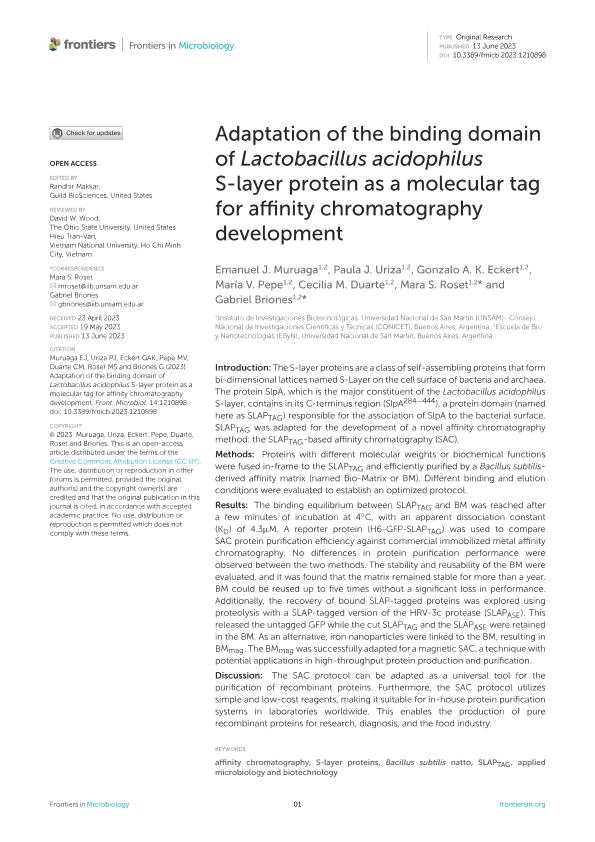Artículo
Adaptation of the binding domain of Lactobacillus acidophilus S-layer protein as a molecular tag for affinity chromatography development
Muruaga, Emanuel Javier ; Uriza, Paula Jimena
; Uriza, Paula Jimena ; Eckert, Gonzalo Axel Klaus
; Eckert, Gonzalo Axel Klaus ; Pepe, María Victoria
; Pepe, María Victoria ; Duarte, Cecilia Magalí
; Duarte, Cecilia Magalí ; Roset, Mara Sabrina
; Roset, Mara Sabrina ; Briones, Carlos Gabriel
; Briones, Carlos Gabriel
 ; Uriza, Paula Jimena
; Uriza, Paula Jimena ; Eckert, Gonzalo Axel Klaus
; Eckert, Gonzalo Axel Klaus ; Pepe, María Victoria
; Pepe, María Victoria ; Duarte, Cecilia Magalí
; Duarte, Cecilia Magalí ; Roset, Mara Sabrina
; Roset, Mara Sabrina ; Briones, Carlos Gabriel
; Briones, Carlos Gabriel
Fecha de publicación:
06/2023
Editorial:
Frontiers Media
Revista:
Frontiers in Microbiology
e-ISSN:
1664-302X
Idioma:
Inglés
Tipo de recurso:
Artículo publicado
Clasificación temática:
Resumen
Introduction: The S-layer proteins are a class of self-assembling proteins that form bi-dimensional lattices named S-Layer on the cell surface of bacteria and archaea. The protein SlpA, which is the major constituent of the Lactobacillus acidophilus S-layer, contains in its C-terminus region (SlpA284 − 444), a protein domain (named here as SLAPTAG) responsible for the association of SlpA to the bacterial surface. SLAPTAG was adapted for the development of a novel affinity chromatography method: the SLAPTAG-based affinity chromatography (SAC). Methods: Proteins with different molecular weights or biochemical functions were fused in-frame to the SLAPTAG and efficiently purified by a Bacillus subtilis-derived affinity matrix (named Bio-Matrix or BM). Different binding and elution conditions were evaluated to establish an optimized protocol. Results: The binding equilibrium between SLAPTAG and BM was reached after a few minutes of incubation at 4°C, with an apparent dissociation constant (KD) of 4.3μM. A reporter protein (H6-GFP-SLAPTAG) was used to compare SAC protein purification efficiency against commercial immobilized metal affinity chromatography. No differences in protein purification performance were observed between the two methods. The stability and reusability of the BM were evaluated, and it was found that the matrix remained stable for more than a year. BM could be reused up to five times without a significant loss in performance. Additionally, the recovery of bound SLAP-tagged proteins was explored using proteolysis with a SLAP-tagged version of the HRV-3c protease (SLAPASE). This released the untagged GFP while the cut SLAPTAG and the SLAPASE were retained in the BM. As an alternative, iron nanoparticles were linked to the BM, resulting in BMmag. The BMmag was successfully adapted for a magnetic SAC, a technique with potential applications in high-throughput protein production and purification. Discussion: The SAC protocol can be adapted as a universal tool for the purification of recombinant proteins. Furthermore, the SAC protocol utilizes simple and low-cost reagents, making it suitable for in-house protein purification systems in laboratories worldwide. This enables the production of pure recombinant proteins for research, diagnosis, and the food industry.
Palabras clave:
LACTOBACILLUS ACIDOPHILUS
,
SLAP TAG
,
AFFINITY CHROMATOGRAPHY
,
BIO-MATRIX
Archivos asociados
Licencia
Identificadores
Colecciones
Articulos (IIBIO)
Articulos de INSTITUTO DE INVESTIGACIONES BIOTECNOLOGICAS
Articulos de INSTITUTO DE INVESTIGACIONES BIOTECNOLOGICAS
Citación
Muruaga, Emanuel Javier; Uriza, Paula Jimena; Eckert, Gonzalo Axel Klaus; Pepe, María Victoria; Duarte, Cecilia Magalí; et al.; Adaptation of the binding domain of Lactobacillus acidophilus S-layer protein as a molecular tag for affinity chromatography development; Frontiers Media; Frontiers in Microbiology; 14; 1210898; 6-2023; 1-15
Compartir
Altmétricas
Items relacionados
Mostrando titulos relacionados por título, autor y tema.
-
Muruaga, Emanuel Javier ; Uriza, Paula Jimena ; Eckert, Gonzalo Axel Klaus ; Pepe, María Victoria ; Duarte, Cecilia Magalí ; Roset, Mara Sabrina ; Briones, Carlos Gabriel (Cold Spring Harbor Laboratory Press, 2022-12)



